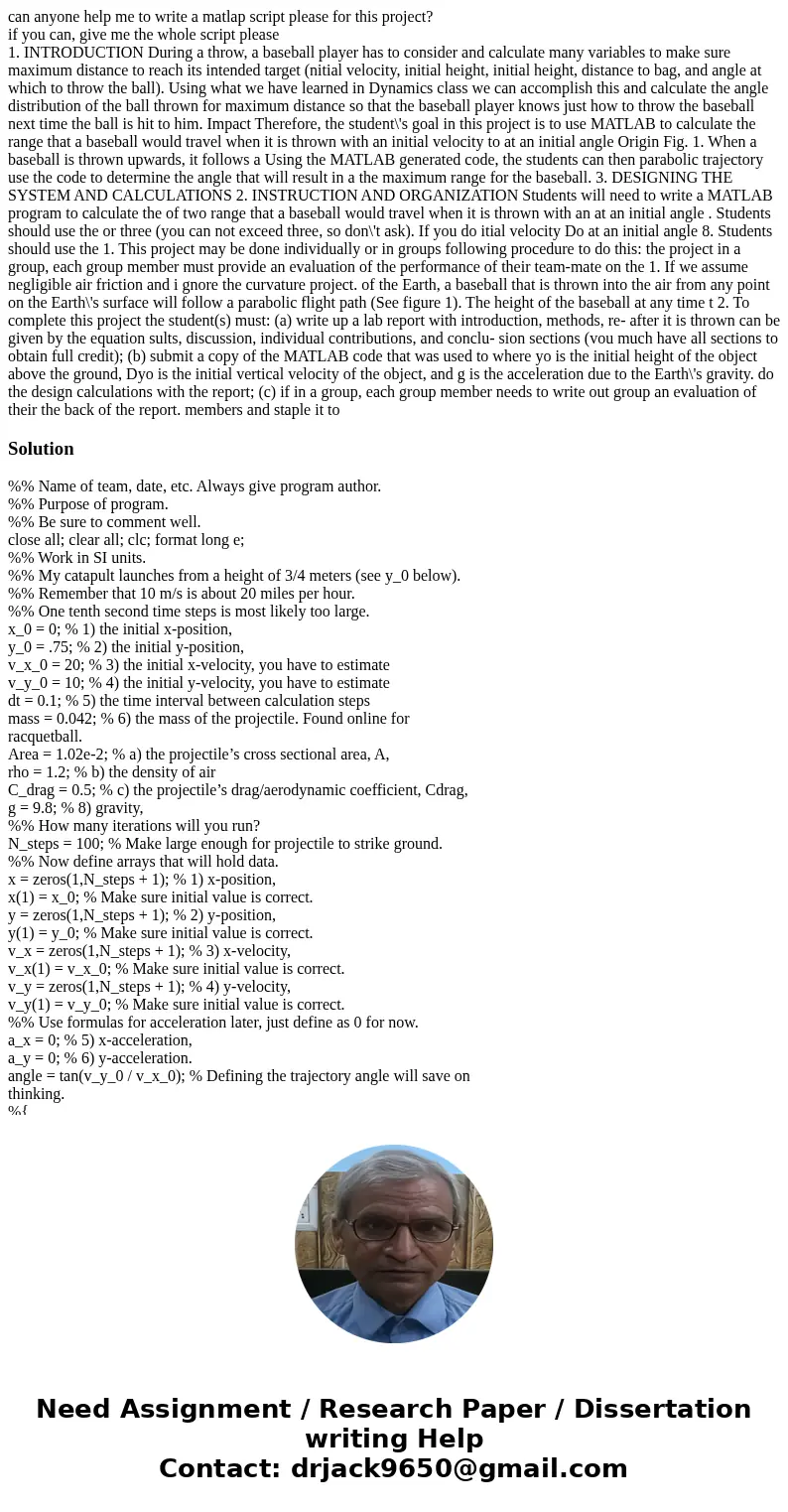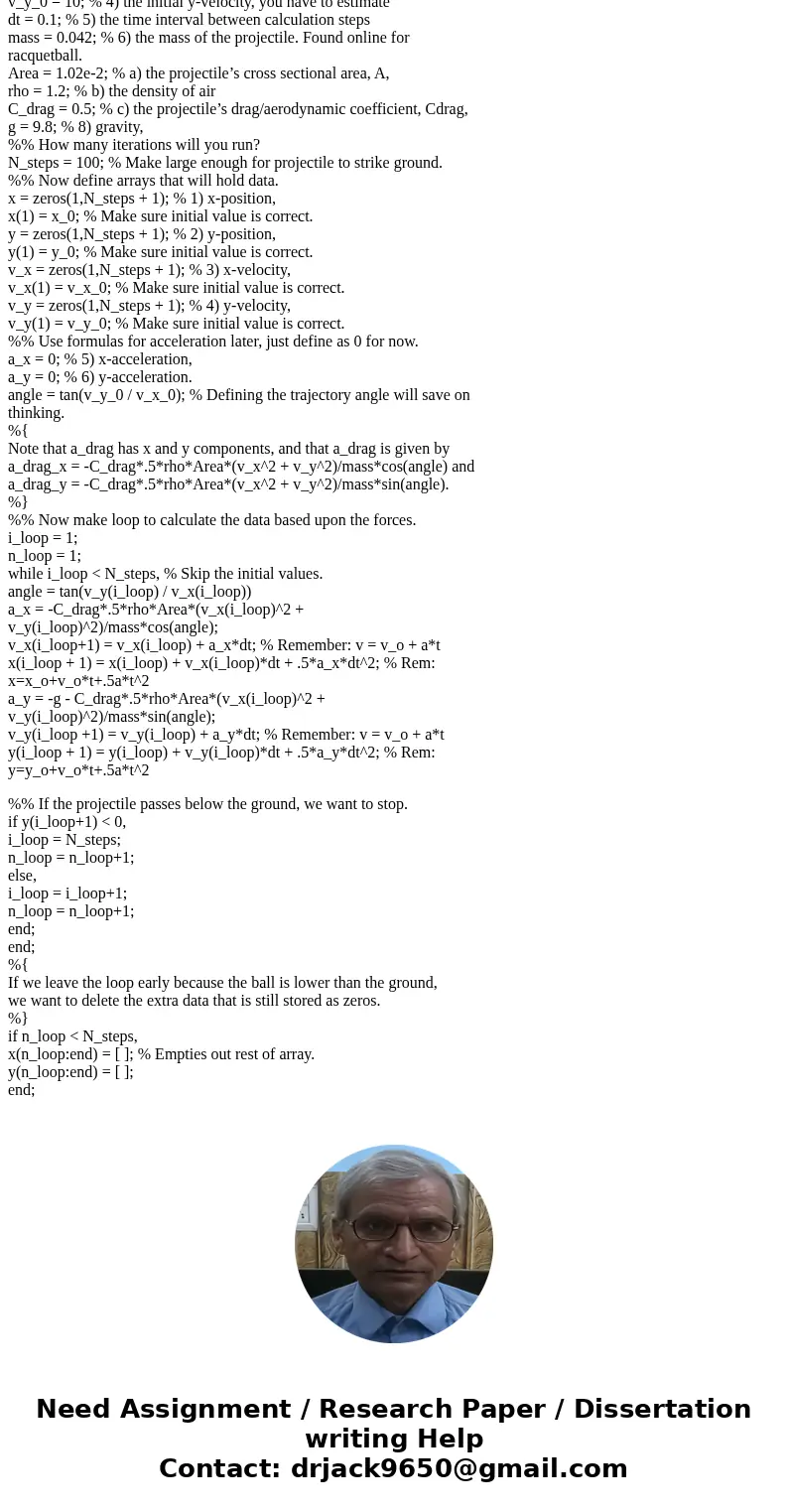can anyone help me to write a matlap script please for this
Solution
%% Name of team, date, etc. Always give program author.
%% Purpose of program.
%% Be sure to comment well.
close all; clear all; clc; format long e;
%% Work in SI units.
%% My catapult launches from a height of 3/4 meters (see y_0 below).
%% Remember that 10 m/s is about 20 miles per hour.
%% One tenth second time steps is most likely too large.
x_0 = 0; % 1) the initial x-position,
y_0 = .75; % 2) the initial y-position,
v_x_0 = 20; % 3) the initial x-velocity, you have to estimate
v_y_0 = 10; % 4) the initial y-velocity, you have to estimate
dt = 0.1; % 5) the time interval between calculation steps
mass = 0.042; % 6) the mass of the projectile. Found online for
racquetball.
Area = 1.02e-2; % a) the projectile’s cross sectional area, A,
rho = 1.2; % b) the density of air
C_drag = 0.5; % c) the projectile’s drag/aerodynamic coefficient, Cdrag,
g = 9.8; % 8) gravity,
%% How many iterations will you run?
N_steps = 100; % Make large enough for projectile to strike ground.
%% Now define arrays that will hold data.
x = zeros(1,N_steps + 1); % 1) x-position,
x(1) = x_0; % Make sure initial value is correct.
y = zeros(1,N_steps + 1); % 2) y-position,
y(1) = y_0; % Make sure initial value is correct.
v_x = zeros(1,N_steps + 1); % 3) x-velocity,
v_x(1) = v_x_0; % Make sure initial value is correct.
v_y = zeros(1,N_steps + 1); % 4) y-velocity,
v_y(1) = v_y_0; % Make sure initial value is correct.
%% Use formulas for acceleration later, just define as 0 for now.
a_x = 0; % 5) x-acceleration,
a_y = 0; % 6) y-acceleration.
angle = tan(v_y_0 / v_x_0); % Defining the trajectory angle will save on
thinking.
%{
Note that a_drag has x and y components, and that a_drag is given by
a_drag_x = -C_drag*.5*rho*Area*(v_x^2 + v_y^2)/mass*cos(angle) and
a_drag_y = -C_drag*.5*rho*Area*(v_x^2 + v_y^2)/mass*sin(angle).
%}
%% Now make loop to calculate the data based upon the forces.
i_loop = 1;
n_loop = 1;
while i_loop < N_steps, % Skip the initial values.
angle = tan(v_y(i_loop) / v_x(i_loop))
a_x = -C_drag*.5*rho*Area*(v_x(i_loop)^2 +
v_y(i_loop)^2)/mass*cos(angle);
v_x(i_loop+1) = v_x(i_loop) + a_x*dt; % Remember: v = v_o + a*t
x(i_loop + 1) = x(i_loop) + v_x(i_loop)*dt + .5*a_x*dt^2; % Rem:
x=x_o+v_o*t+.5a*t^2
a_y = -g - C_drag*.5*rho*Area*(v_x(i_loop)^2 +
v_y(i_loop)^2)/mass*sin(angle);
v_y(i_loop +1) = v_y(i_loop) + a_y*dt; % Remember: v = v_o + a*t
y(i_loop + 1) = y(i_loop) + v_y(i_loop)*dt + .5*a_y*dt^2; % Rem:
y=y_o+v_o*t+.5a*t^2
%% If the projectile passes below the ground, we want to stop.
if y(i_loop+1) < 0,
i_loop = N_steps;
n_loop = n_loop+1;
else,
i_loop = i_loop+1;
n_loop = n_loop+1;
end;
end;
%{
If we leave the loop early because the ball is lower than the ground,
we want to delete the extra data that is still stored as zeros.
%}
if n_loop < N_steps,
x(n_loop:end) = [ ]; % Empties out rest of array.
y(n_loop:end) = [ ];
end;


 Homework Sourse
Homework Sourse